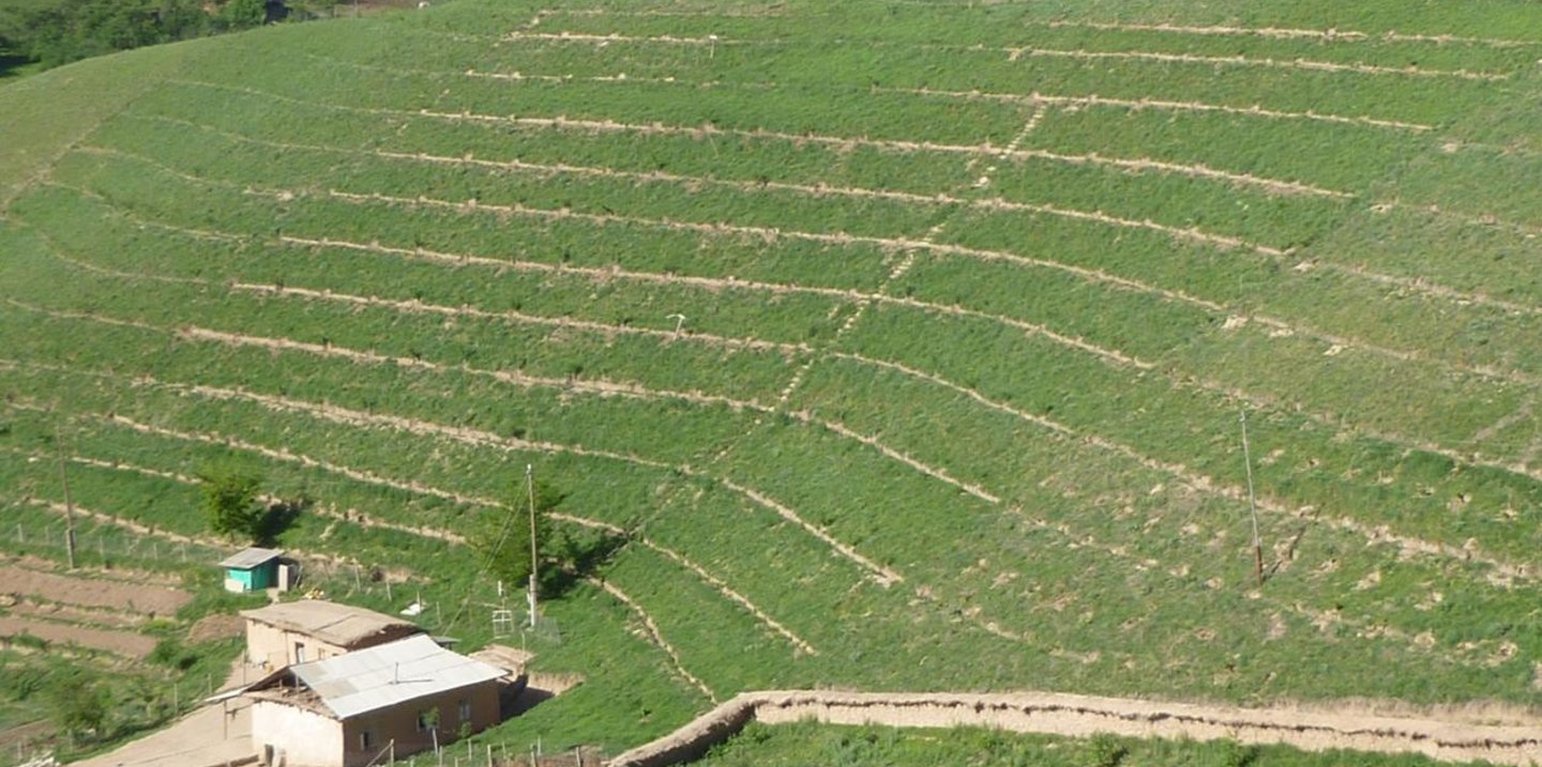



The SLM technology is thought to stop water run-off resulting in the prevention of damage to the top soil on steep slopes. This enables better distribution and infiltration of water into the soil. A complementing live fence, along with a metal net along the perimeter aim to stop livestock grazing. Contour ditches are planted in intervals with fruit trees, and the live fence is made of a combination of fire wood, trees and bushes. This combination makes possible the establishment of an agro forestry system on a slope in an area with limited irrigation using making use of the natural rainfall.
Details: 1. Ditches are dug out along the contour lines drawn by an "A" frame on the slope. 2. Seedlings are planted in 5 metre intervals, positioned right in the middle of the ditch. 3. The back wall behind each tree (upslope) has a half moon cutting to enable an even water/moisture supply. 4. The ditches are barriered with "septas" between two trees to trap water in the individual sections. 5. Horizontally across the ditches, the tree species vary, but vertically are homogeneous. 6. The strips between ditches are left free to enable natural grass to grow. 7. The residual soil material is mounted in front of the ditches in piles the width of a shovel. 8. The complementing perimeter live fence and metal net (1.5m height) is supported by wooden poles made of Acacia trees. (Assumed life span of poles is 25 years). 9. Improvised drip irrigation with 5 litre plastic bottles is used together with mulch coverage beneath the trees. 10. Species composition: apple, cherry, apricot, grape, walnut, pomegranate. In the garden; species of Acacia, Ailantus, dogroses and willow act as a live fence.
Purpose of the Technology: The aim of this system is to significantly reduce the water run-off that removes the top soil, and to subsequently prevent water erosion, and the formation/development of gullies. This can be achieved through the following methods; conserving the available resources and using them more efficiently, prevention overgrazing and improving the natural soil cover, as well as changing the type of land management towards a more sustainable and profitable one.
Establishment / maintenance activities and inputs: The plot was established on one side of a micro watershed. In mid February the contour lines were identified using an “A” frame. Digging of contour ditches then took until late February. The material was accumulated down the slope in deposits the width of a shovel to build a riser. At the beginning of March all the fruit tree seedlings were planted in the middle of the ditches. Perimeter fencing was constructed and live fence plants were planted up until late March. In May, the grass around the trees was cut and used for mulching beneath the trees. During June and July in the first year the plants needed watering 3 times a week which was done using a drip irrigation system with 5 litre plastic bottles. To help prevent the water heating and evaporating, the bottles were left under the mulch cover. Mulching and irrigation are repeated every dry and hot season. Every spring, the soil material is removed alongside the inner wall of the ditch just taking an amount that equals the width of a shovel, and accumulated down the slope to extend the riser. Materials required include: (1) Ditches: hand tools, stakes, rope, “A” frame, (2) Live fence: seedlings of Acacia, Ailantus, willow and dog rose, (3) Fencing: metal net, wooden poles, metal wire, (4) Cow dung, lime suspension, straw, mulch, plastic bottles.
Natural / human environment: The watershed can be characterised as follows: Hydrology - surface water is available only at times of rain and snow melt, this can be used for irrigation only. No sources of potable water exist. Soils are of loess type, as generally characteristic to the whole area. Flora - natural grasses prevail in the micro watershed, 9 species could be identified. Natural bushes and trees were completely removed due to high demand for fuelwood. Cultivation of rare tree varieties and household gardening was practiced in advance of the project. Fauna - Wild animals are often still seen such as turtles, lizards and snakes. Farm animals - mixed breeds of cattle, sheep and goats are very important. The households in this micro watershed area own almost 350 animals. The majority of these are kept for the summer season in adjacent pastures. The micro watershed was first inhabited in early 2000. Five households were established with a total of around 40 inhabitants. Family heads tend to be in their early 40s. Families have 7 to 9 members, including 5 to 7 children. All are of Tajik ethnicity, and Muslim, open to secular values. Of these 5 households, only 4 households have adopted the SLM technology. The fifth household only decided to join the project after witnessing their neighbour’s positive experiences. Both spouses tended to be involved in the activities. Both men and women took part in the training sessions and orientation meeting. However, it is likely that most decisions were made by the men, after the women had shared their ideas. Work load: providing the external inputs, construction and the heavy manual labour were done by the men. Maintenance work: watering, mulching and grass cutting was shared between men and women. Digging and fencing were performed in "hashars" - community labour groups. As women spend more time at home working within their households, they tend to perform more maintenance work on the plot compared to men. Other activities away from the farms are important to the family budget providing a means of extra income. This often includes men’s long term migration to Russia to find work.
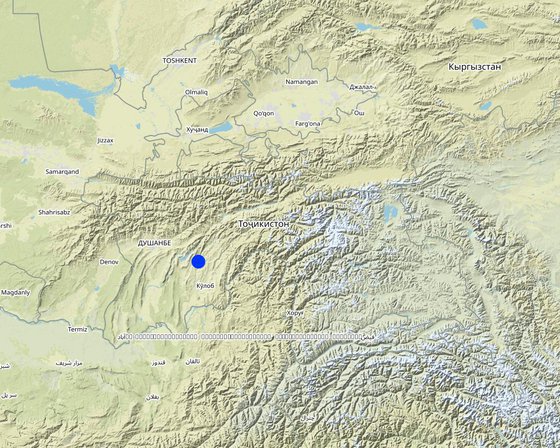
ສະຖານທີ່: Baljuvon, Khirob, Tajikistan, Khatlon, ຕາຈິກິສະຕານ
ຈໍານວນ ພື້ນທີ່ ທີ່ໃຊ້ ເຕັກໂນໂລຢີ ທີ່ໄດ້ວິເຄາະ:
ການແຜ່ກະຈາຍຂອງເຕັກໂນໂລຢີ:
ຢູ່ໃນເຂດປ່າສະຫງວນທີ່ບໍ?:
ວັນທີຂອງການປະຕິບັດ: ຕໍ່າກວ່າ 10 ປີ ຜ່ານມາ (ມາເຖິງປະຈຸບັນ)
ປະເພດຂອງການນໍາສະເໜີ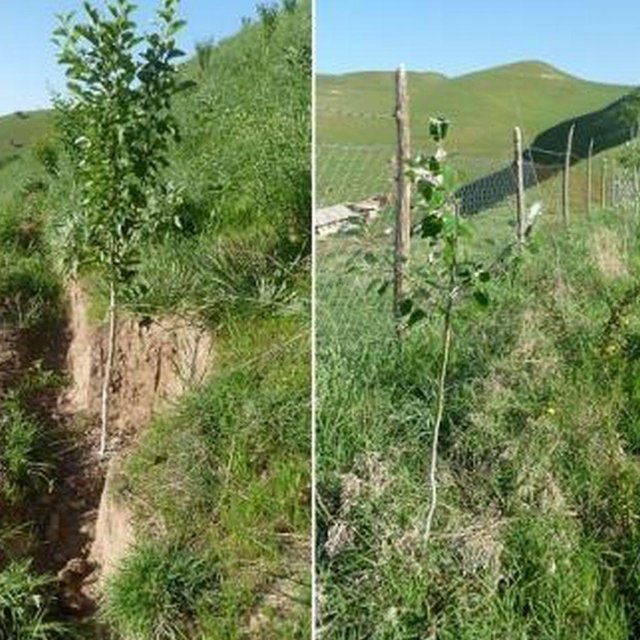
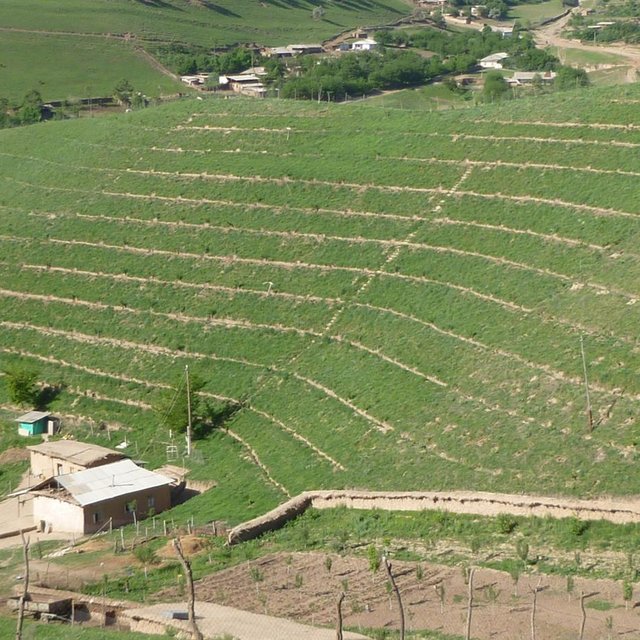









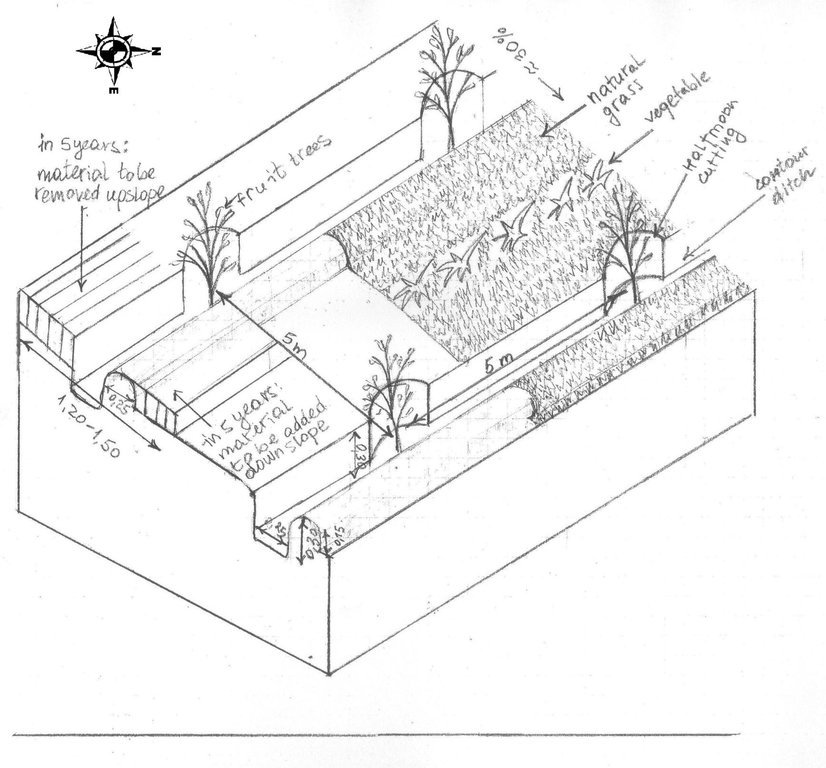
| ລະບຸ ປັດໃຈ ນໍາເຂົ້າ ໃນການຜະລີດ | ຫົວໜ່ວຍ | ປະລິມານ | ຕົ້ນທຶນ ຕໍ່ຫົວໜ່ວຍ (Somoni) | ຕົ້ນທຶນທັງໝົດ ຂອງປັດໃຈຂາເຂົ້າ ໃນການຜະລິດ (Somoni) | % ຂອງຕົ້ນທຶນທັງໝົດ ທີ່ຜູ້ນໍາໃຊ້ທີ່ດິນ ໃຊ້ຈ່າຍເອງ |
| ແຮງງານ | |||||
| Labour | 1.0 | 355.0 | 355.0 | 100.0 | |
| Mulching | 1.0 | 4.5 | 4.5 | 100.0 | |
| Planting seedlings in contour ditches | person days | 20.0 | 4.4 | 88.0 | 100.0 |
| Planting seedlings and bushes along the perimeter | person days | 10.0 | 4.4 | 44.0 | 100.0 |
| ອຸປະກອນ | |||||
| Set of shovels, hoes, picks | Set | 1.0 | 66.0 | 66.0 | 50.0 |
| ວັດສະດຸໃນການປູກ | |||||
| mulching | 1.0 | 4.5 | 4.5 | 100.0 | |
| seedlings | 1.0 | 333.0 | 333.0 | 50.0 | |
| Seedlings: frutiouse and firewood trees | ha | 500.0 | 0.666 | 333.0 | 50.0 |
| ວັດສະດຸກໍ່ສ້າງ | |||||
| Wood frame | Piece | 1.0 | 3.0 | 3.0 | 100.0 |
| ອື່ນໆ | |||||
| Labour: Gradual terracing by Broadening the ditch onslope and extending the raiser downslope | person days | 150.0 | 0.68 | 102.0 | 100.0 |
| ຕົ້ນທຶນທັງໝົດ ໃນການຈັດຕັ້ງປະຕິບັດ ເຕັກໂນໂລຢີ | 1'333.0 | ||||
| ຄ່າໃຊ້ຈ່າຍທັງໝົດ ສຳລັບການສ້າງຕັ້ງເຕັກໂນໂລຢີ ເປັນສະກຸນເງີນໂດລາ | 296.22 | ||||
| ລະບຸ ປັດໃຈ ນໍາເຂົ້າ ໃນການຜະລີດ | ຫົວໜ່ວຍ | ປະລິມານ | ຕົ້ນທຶນ ຕໍ່ຫົວໜ່ວຍ (Somoni) | ຕົ້ນທຶນທັງໝົດ ຂອງປັດໃຈຂາເຂົ້າ ໃນການຜະລິດ (Somoni) | % ຂອງຕົ້ນທຶນທັງໝົດ ທີ່ຜູ້ນໍາໃຊ້ທີ່ດິນ ໃຊ້ຈ່າຍເອງ |
| ແຮງງານ | |||||
| Drip irrigation with plastic bottles | person days | 15.0 | 4.44 | 66.6 | 100.0 |
| Mulching | person days | 5.0 | 4.44 | 22.2 | 100.0 |
| Shaping the trees, cutting branches | person days | 5.0 | 4.44 | 22.2 | 100.0 |
| Grafting | person days | 5.0 | 4.44 | 22.2 | 100.0 |
| ວັດສະດຸໃນການປູກ | |||||
| mulching | 1.0 | 22.0 | 22.0 | 100.0 | |
| ອື່ນໆ | |||||
| Labour: Manuring | person days | 3.0 | 4.4 | 13.2 | 100.0 |
| ຕົ້ນທຶນທັງໝົດ ທີ່ໃຊ້ໃນການບໍາລຸງຮັກສາ ເຕັກໂນໂລຢີ | 168.4 | ||||
| ຄ່າໃຊ້ຈ່າຍທັງໝົດ ສຳລັບການບົວລະບັດຮກສາເຕັກໂນໂລຢີ ເປັນສະກຸນເງີນໂດລາ | 37.42 | ||||
ປະລິມານ ກ່ອນການຈັດຕັ້ງປະຕິບັດ ການຄຸ້ມຄອງ ທີ່ດິນແບບຍືນຍົງ: very little fodder could be collected
ປະລີມານ ຫຼັງການຈັດຕັ້ງປະຕິບັດ ການຄຸ້ມຄອງ ທີ່ດິນແບບຍືນຍົງ: cut and carry fodder production
ປະລິມານ ກ່ອນການຈັດຕັ້ງປະຕິບັດ ການຄຸ້ມຄອງ ທີ່ດິນແບບຍືນຍົງ: not possible
ປະລີມານ ຫຼັງການຈັດຕັ້ງປະຕິບັດ ການຄຸ້ມຄອງ ທີ່ດິນແບບຍືນຍົງ: may cover 40 -50 percent of HH need only in 5 year
ປະລິມານ ກ່ອນການຈັດຕັ້ງປະຕິບັດ ການຄຸ້ມຄອງ ທີ່ດິນແບບຍືນຍົງ: no
ປະລີມານ ຫຼັງການຈັດຕັ້ງປະຕິບັດ ການຄຸ້ມຄອງ ທີ່ດິນແບບຍືນຍົງ: yes
ປະລິມານ ກ່ອນການຈັດຕັ້ງປະຕິບັດ ການຄຸ້ມຄອງ ທີ່ດິນແບບຍືນຍົງ: None
ປະລີມານ ຫຼັງການຈັດຕັ້ງປະຕິບັດ ການຄຸ້ມຄອງ ທີ່ດິນແບບຍືນຍົງ: yes
ປະລິມານ ກ່ອນການຈັດຕັ້ງປະຕິບັດ ການຄຸ້ມຄອງ ທີ່ດິນແບບຍືນຍົງ: no
ປະລີມານ ຫຼັງການຈັດຕັ້ງປະຕິບັດ ການຄຸ້ມຄອງ ທີ່ດິນແບບຍືນຍົງ: yes
ປະລິມານ ກ່ອນການຈັດຕັ້ງປະຕິບັດ ການຄຸ້ມຄອງ ທີ່ດິນແບບຍືນຍົງ: None
ປະລີມານ ຫຼັງການຈັດຕັ້ງປະຕິບັດ ການຄຸ້ມຄອງ ທີ່ດິນແບບຍືນຍົງ: yes
ປະລິມານ ກ່ອນການຈັດຕັ້ງປະຕິບັດ ການຄຸ້ມຄອງ ທີ່ດິນແບບຍືນຍົງ: no
ປະລີມານ ຫຼັງການຈັດຕັ້ງປະຕິບັດ ການຄຸ້ມຄອງ ທີ່ດິນແບບຍືນຍົງ: yes
ປະລິມານ ກ່ອນການຈັດຕັ້ງປະຕິບັດ ການຄຸ້ມຄອງ ທີ່ດິນແບບຍືນຍົງ: no
ປະລີມານ ຫຼັງການຈັດຕັ້ງປະຕິບັດ ການຄຸ້ມຄອງ ທີ່ດິນແບບຍືນຍົງ: yes